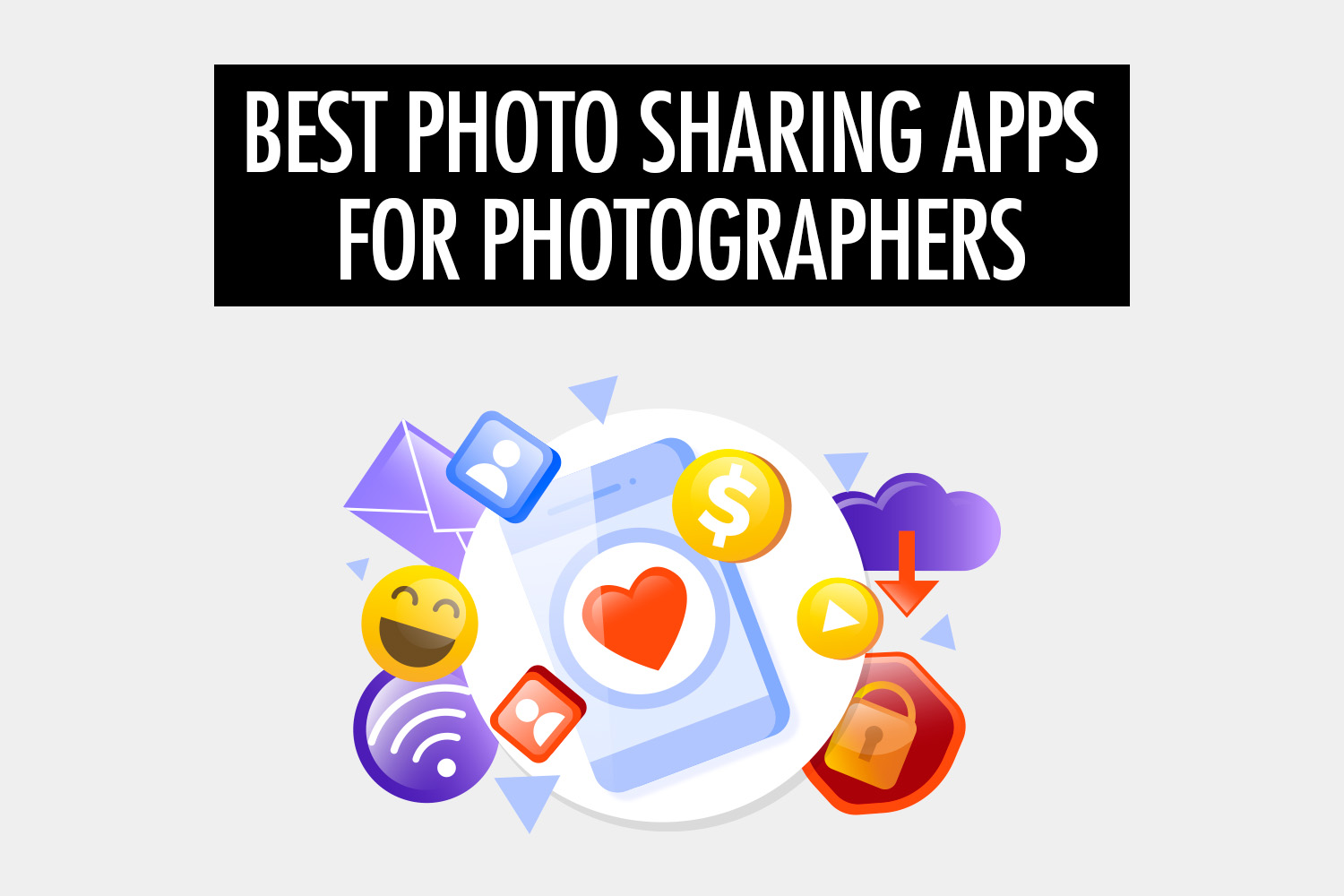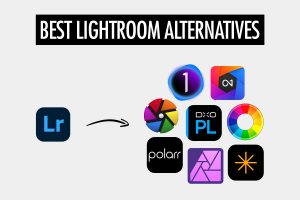Which is the best photo sharing app for photographers?
The answer depends on what you’re looking to achieve.
There are hundreds of photo sharing apps available, and they are designed for different purposes.
Some are designed to help you instantly share your event photos, while others are designed to help you build an audience.
In this article, we round up and categorize all of the best photo sharing apps today.
We categorize them based on their primary purpose:
- Instantly share photos while shooting
- Deliver photos in a client gallery
- Deliver photos with face recognition
- Sell photos
- Build a website
- Build an audience
- Store photos
Keep in mind that some apps have more than one purpose. For example, several apps help you deliver photos in a client gallery and sell photos.
When this happens, we classify them by their main focus—based on their feature sets.
Let’s get to it.
Instantly Share Photos While Shooting
Expectations are changing when it comes to event, wedding and portrait photography.
Now, people expect to be able to get their photos instantly, right after a photographer takes them.
And why shouldn’t they?
After all, we can instantly take and share photos on our smartphones.
These photo sharing apps help you to do just that, but from your mirrorless cameras or DSLRs.
Honcho
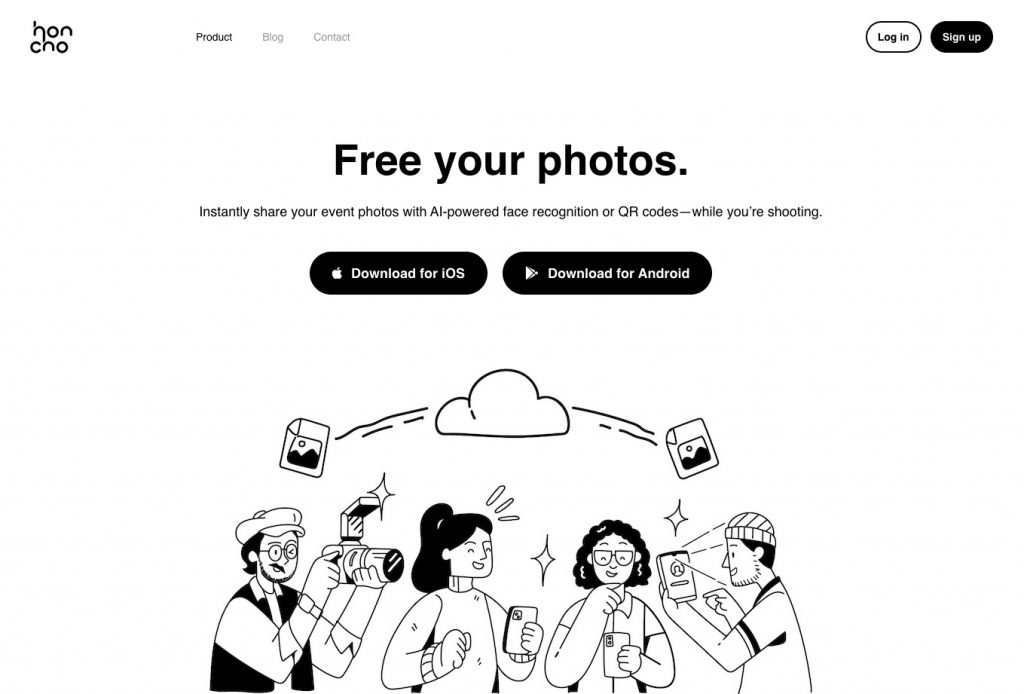
Honcho lets you upload photos from camera to cloud, while you’re shooting.
This is done by tethering your camera to their mobile app, which is available for both iOS and Android.
After uploading, you can instantly apply editing presets or have an assistant edit the photos with the built-in collaborative photo editor. This makes it possible to deliver polished edits in just seconds.
Then, you can instantly share the photos with AI-powered face recognition or QR codes.
Honcho helps you earn more from every event by selling your photos. And because the photos are delivered live, at the height of the excitement, you capture sales when guests are most eager to buy. Everything runs automatically while you shoot—just add an online store with one click and make your gallery instantly shoppable.
It also lets you create live slideshows and print wirelessly, all from a single platform.
These are all features that can help you generate photo sales, close more bookings and charge higher rates for your events.
In fact, Honcho has helped photographers increase sales by 52% and eliminate 90% of manual tasks.
Honcho offers a free plan so you can sign up right away and get started. Paid plans start at USD39 per month.
Sign up for a free Honcho account today and see how it can transform your photography business.
In addition, you can join the affiliate program and earn up to USD$88.50 for every new customer that you refer to us. That’s a generous commission!
SpotMyPhotos
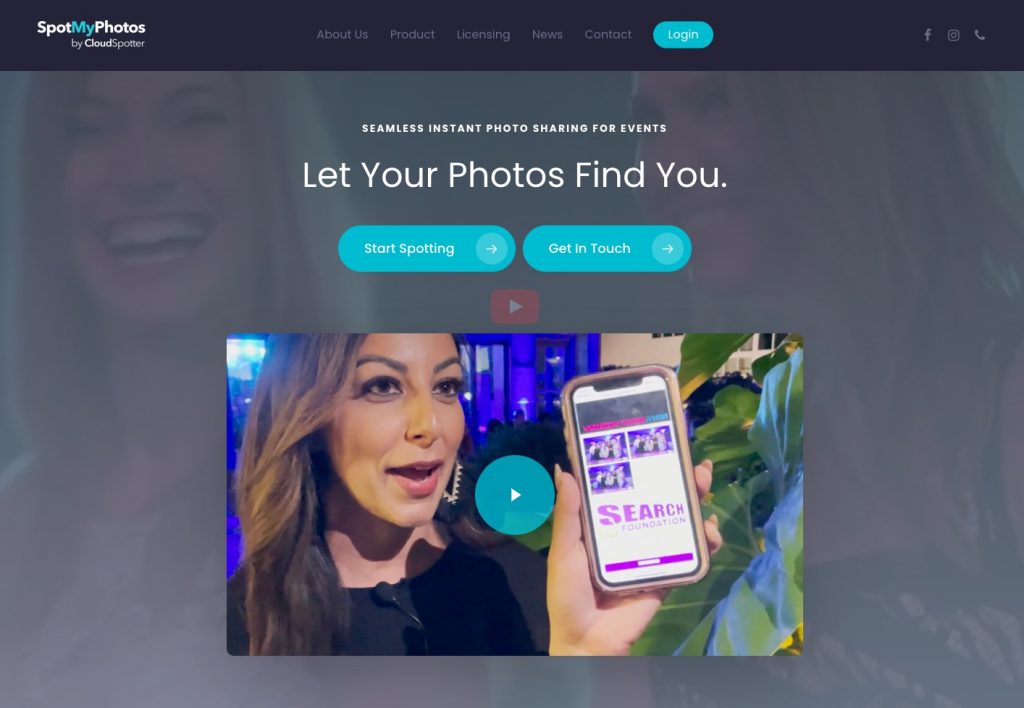
SpotMyPhotos has a similar offering to Honcho—upload your photos while you shoot, and share them by face recognition.
They offer a couple of ways to upload your photos:
- By tethering your camera to their mobile app, which is available only on iOS.
- By using their WiFi enabled SD card, which you can purchase from them.
SpotMyPhotos also has options to create live slideshows and print on-site.
Unfortunately, SpotMyPhotos doesn’t have a free plan for you to try out with. Their monthly subscription plans start at USD195.
Deliver Photos in a Client Gallery
There are many photo sharing apps that cater to professional photographers, to help them deliver photos to their clients.
Their main selling point is in the presentation of the photos—in customisable galleries that clients can easily download their photos from.
It provides a more professional experience, compared to simply delivering the photos via Dropbox.
Many have additional features, such as the ability to proof the photos and sell prints.
Pixieset
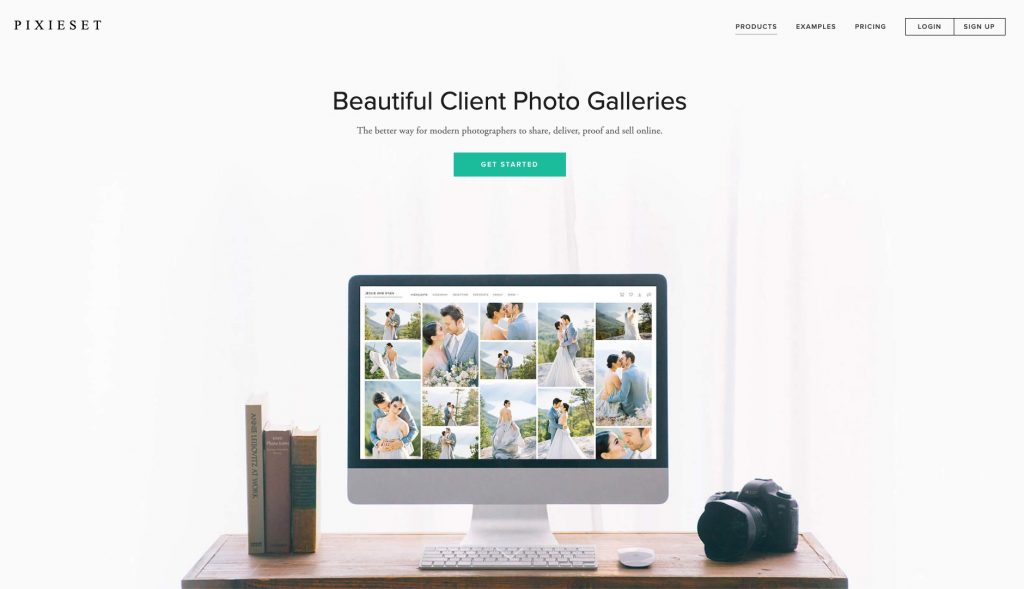
Pixieset comes with a large set of features, but their client gallery has always been their focus—and the main reason photographers use them.
You can customize the gallery or choose from ready-made templates.
Just as importantly, you have control over the sizes of the photos that are available for download. For example, you might only offer low resolution images for free, while adding a price to the full resolution images.
Apart from the client gallery, Pixieset also has options for creating a website, creating a store to sell prints, and a CRM/scheduling software to manage your bookings.
Pixieset offers a free plan with a pretty generous 3GB of storage, which is enough for you to test out its features. Paid plans start at USD8 per month.
ShootProof
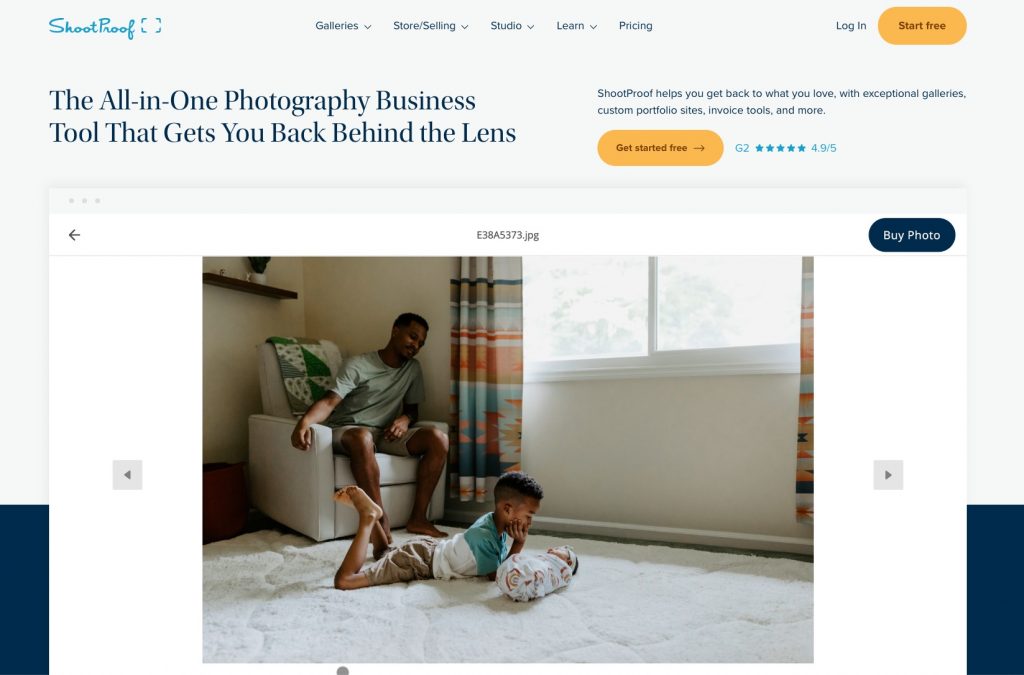
ShootProof has a very similar value offering as Pixieset, with the ability to create client galleries, websites, sell prints and manage your bookings.
Similarly, you can customize the look and feel of the galleries, and control the quantity and quality of free and paid digital downloads.
ShootProof has a more restrictive free plan that offers storage for only 100 photos. Paid plans start at USD10.99.
Pic-Time
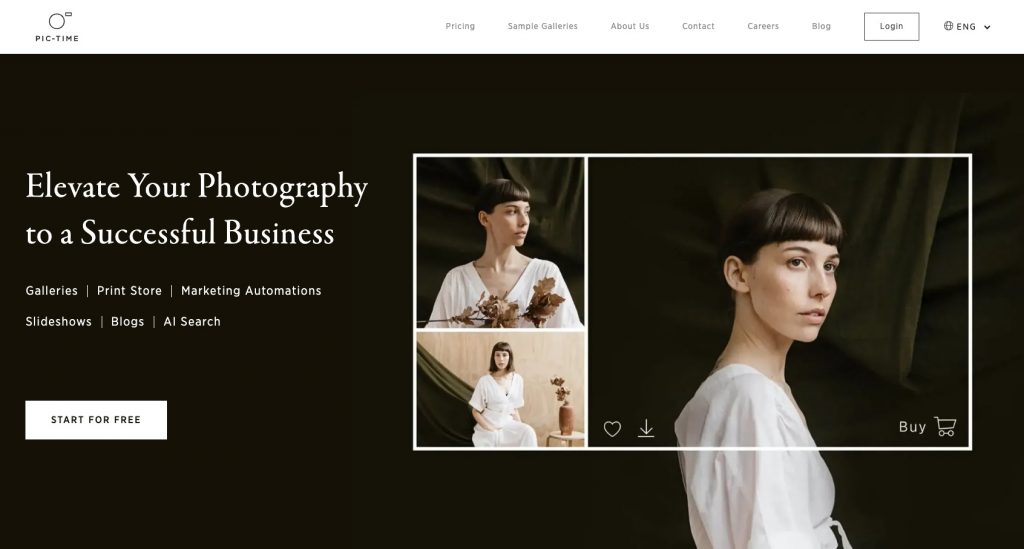
Pic-Time is another platform that offers a range of features to help photographers run their businesses.
They offer client galleries that—you guessed it—can be customized, with the option to sell prints online.
One unique feature that Pic-Time offers is AI gallery search, so that visitors can quickly find the photos they appear in or that interest them. For example, they can search for “speech” and get results for just that—photos of a person making a speech.
It remains to be seen how well it works, but it can be a game changer in how photos are delivered.
Pic-Time offers a free plan with 10GB of storage for the first 6 months, which will be downgraded to 3GB after 6 months. Nevertheless, it’s a generous plan, so we’re not going to complain.
Paid plans start at USD7 per month.
CloudSpot
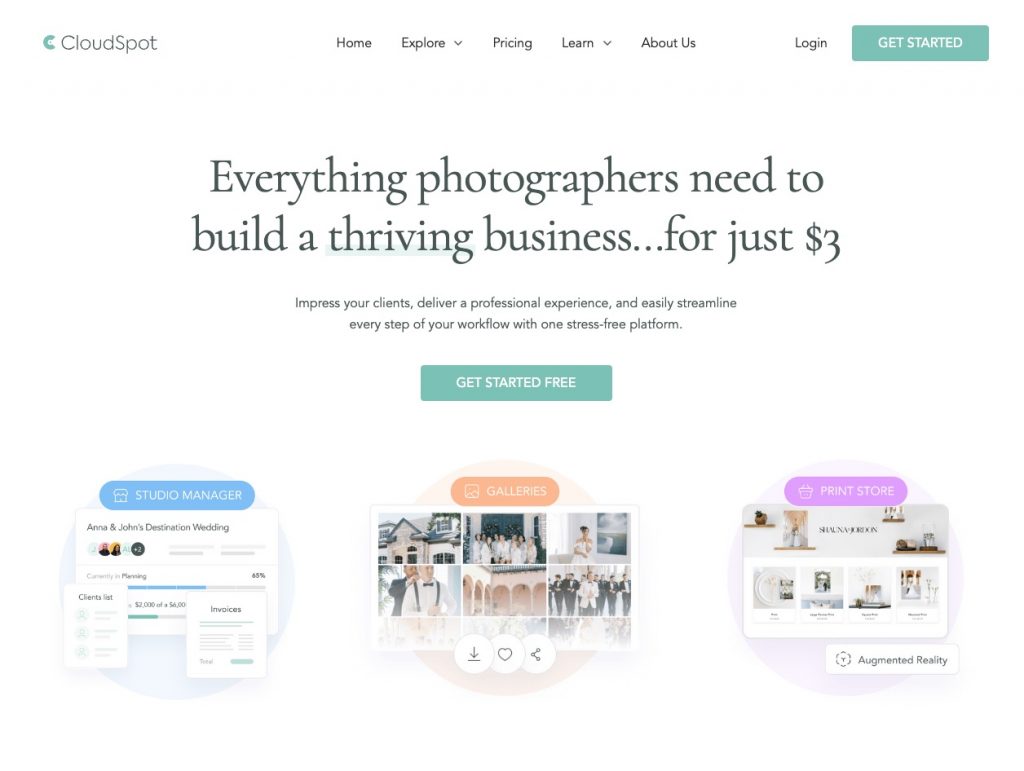
CloudSpot has a similar set of features as the previous 3 options—with client galleries, a print store and a studio manager to manage and schedule bookings.
Like the rest, they offer an all-in-one tool to manage your photography business.
They position themselves as the cost effective option. Direct comparisons with Pixieset and ShootProof on their website highlight their lower prices.
CloudSpot offers a free plan with 10GB of storage. Paid plans start at USD15 per month.
SmugMug
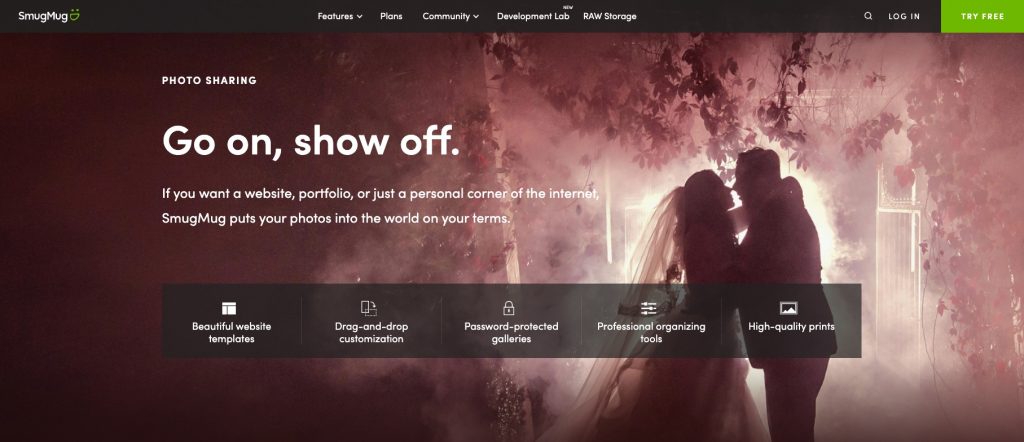
SmugMug has been in the game since 2002, and it’s one of the most established names in the space.
Their focus is primarily in photo sharing and photo storage.
Photo sharing helps photographers to deliver their photos in customizable client galleries and create portfolio websites.
Photo storage allows photographers to back up their photos—including RAW files—in the cloud.
SmugMug offers a 14-day free trial. After that, paid plans start at USD34 per month.
Zenfolio
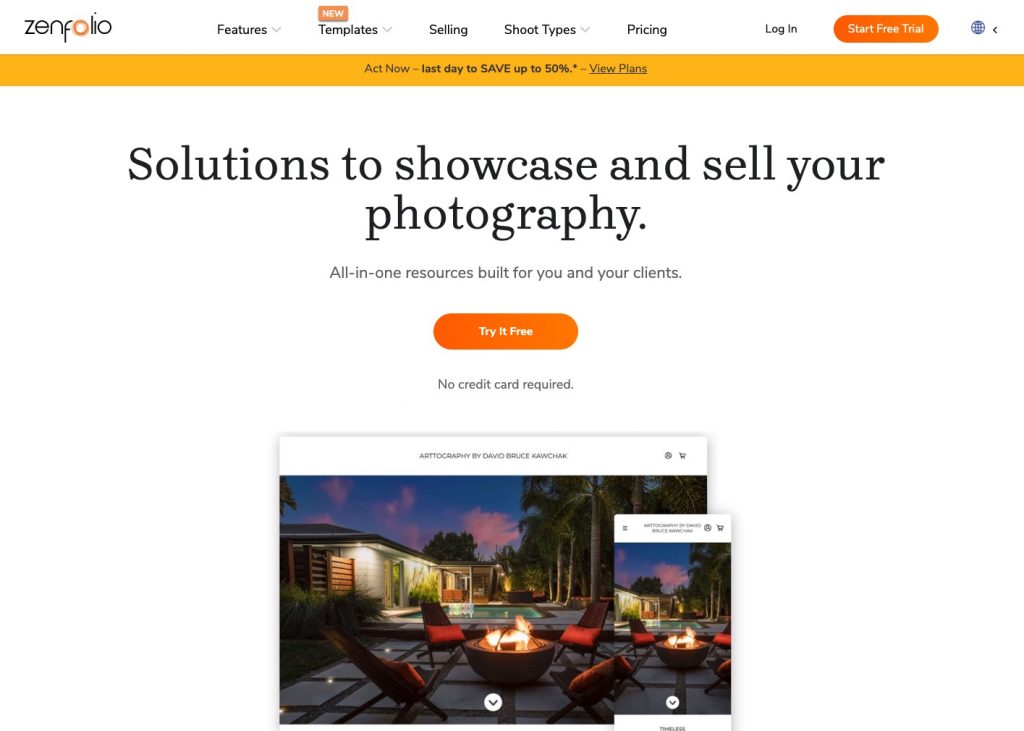
Zenfolio is another industry stalwart, having been in business since 2004.
Over time, it has built features beyond the client gallery—it now includes an online store, and automated booking and payment.
It has also launched PhotoRefine.ai, a desktop app which automatically culls your photos with AI, as a free tool for paid subscribers on their highest subscription tier.
Zenfolio’s paid plans start at USD9 per month, for their client galleries and website builder.
Gump
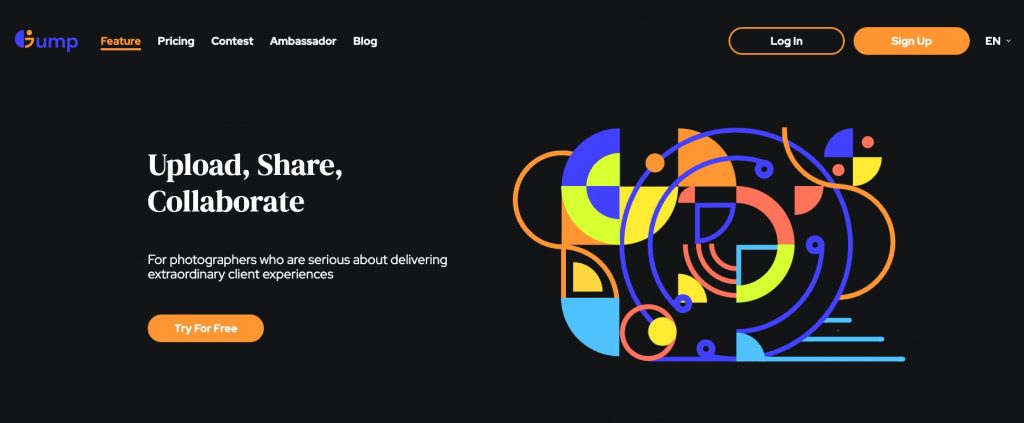
Gump is one of the newest players on the block, and their users are mainly from Asia.
Their offering is relatively simple—client galleries that help photographers collaborate with their clients.
Hence, clients can select, comment and draw on photos in the galleries—to easily provide feedback to their photographers. This cuts down on the back-and-forth conversations over email, and speeds up the editing process.
Gump offers a free plan with 30GD of storage. Paid plans start at USD12.99 per month.
Deliver Photos With Face Recognition
There has been a rise in companies offering client galleries, with a key difference.
The key difference is that these galleries come with face recognition built in.
This allows anyone to easily find their own photos in the gallery, without having to browse through the whole gallery.
It’s especially useful for events and weddings, and helps photographers send the right photos to the right people automatically.
All of them work in a similar way—upload your photos to their platforms after the event, and the platforms will help to distribute the photos with face recognition.
Kwikpic
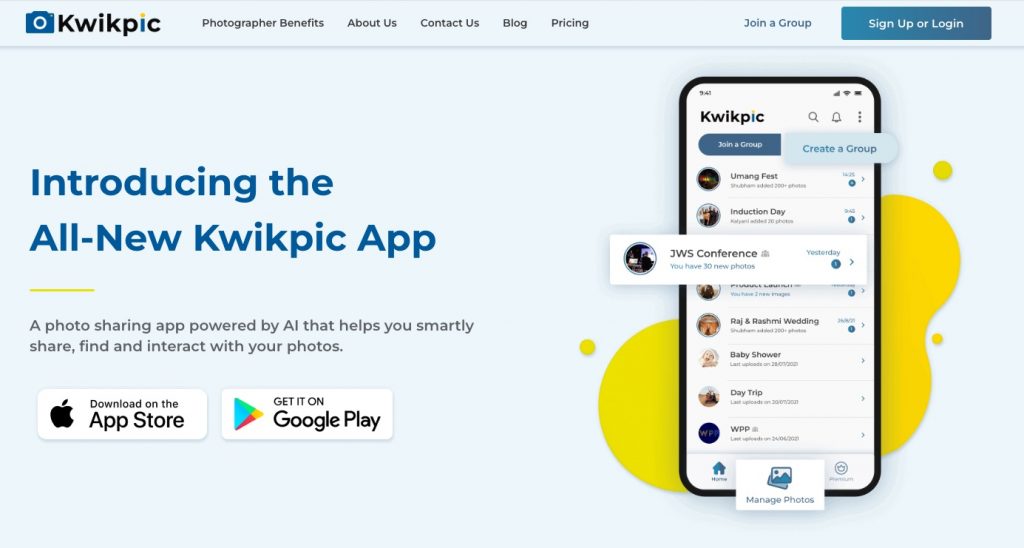
Kwikpic allows you to create a group for any occasion. Then, you can invite anyone to upload photos to the group, and the app will detect the people in the photos with face recognition.
This is obviously also useful for photographers to deliver photos to their clients, especially for events and weddings. Hence, the attendees will be able to easily find their own photos, without having to browse through the whole gallery.
You can customize the design of the gallery and use privacy settings to control access to the photos.
Kwikpic offers a free plan for up to 1000 photos. Their paid plans start at USD19.99 per month, with a minimum commitment of 3 months.
Photier
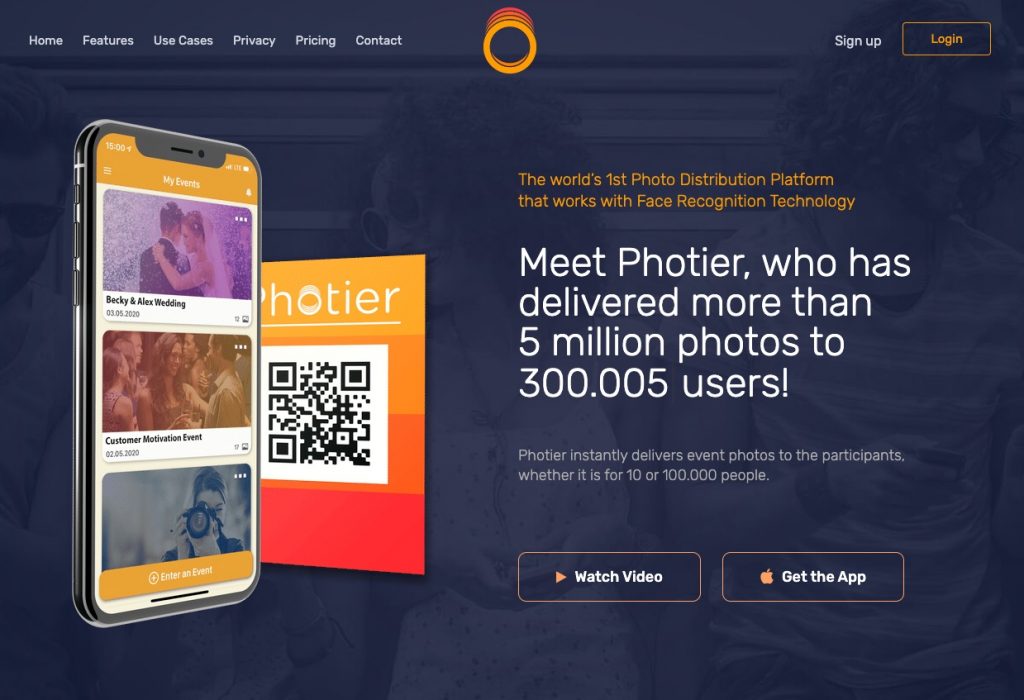
Photier helps you distribute your photos with face recognition, with an accuracy of 99.9%.
In order for attendees to get their photos, they will have to download the Photier app and upload a selfie.
After the event, photographers can upload their photos, which will be automatically matched and sent to the attendees.
According to Photier, they have delivered more than 5 million photos to 300,000 attendees.
Photier’s plans work based on credits—where 1 credit is used to distribute 1 photo. When you sign up, you’ll get 100 credits for free.
After that, paid plans start at USD199 for 500 credits.
Memzo
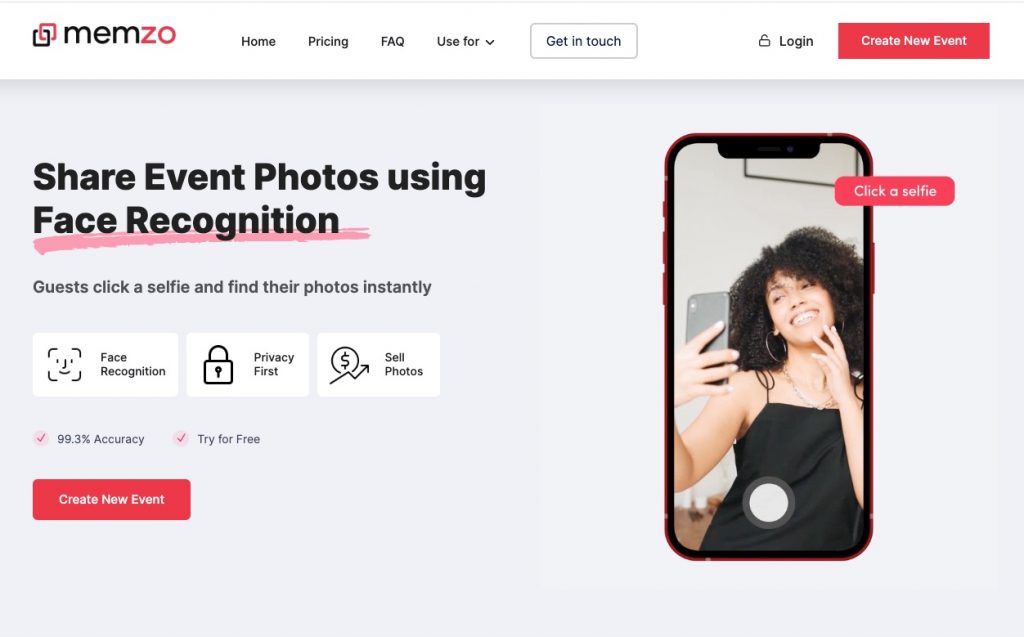
Like Kwikpic and Photier, Memzo helps you distribute photos with face recognition—with an accuracy of 99.3%.
It also gives you the option to sell your photos, with a 0% commission rate.
The easier it is for attendees to find their own photos, the more likely they are to buy them—which makes these 2 features work so well together.
It’s perfect for events like marathons and school portraits, where it’s common for photographers to sell the photos and prints. Automatic distribution with face recognition takes away a lot of the manual work in tagging the photos and identifying the participants.
Memzo’s paid plans start at 3¢ per photo uploaded to their platform, and the first 300 photos are free.
Foto Owl
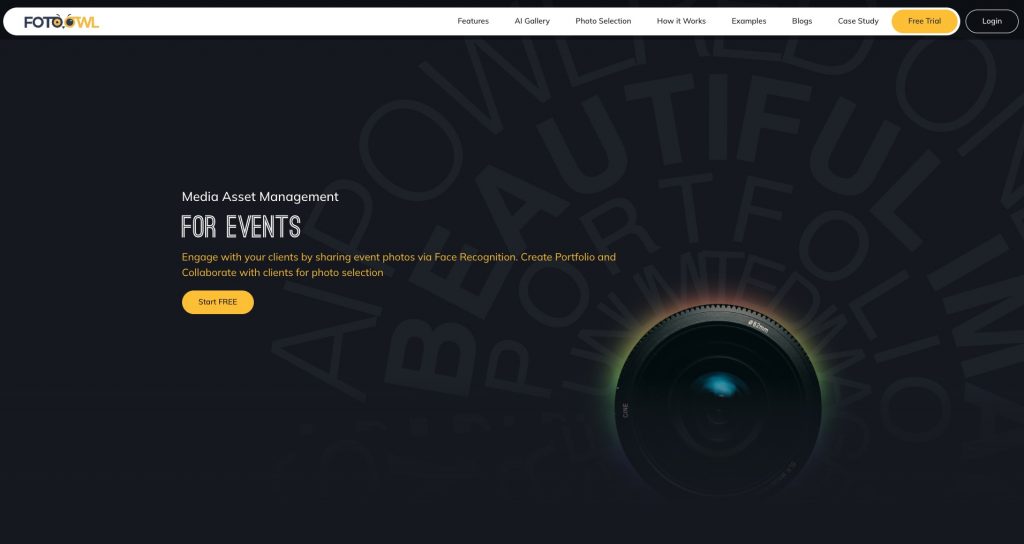
Foto Owl helps you share photos with face recognition, using customizable galleries.
Their galleries include an enquiry form, so that anyone interested in your work can contact you directly. It’s a great way to generate leads from the attendees of an event or wedding.
It also offers proofing features, so that clients can select and comment on the photos. This helps photographers collaborate with their clients more efficiently.
Foto Owl offers a free 1-month trial, with 10GB of storage. After that, paid plans start at USD155 per year, with an annual commitment.
Sell Photos
There are several photo sharing apps that focus on helping photographers sell their photos.
They are usually designed for events, such as marathons and graduation photo shoots—where the sales of digital downloads and prints are a primary source of revenue for photographers.
These events tend to be tricky to manage, due to the large volume of photos. Tagging the photos and identifying the participants can become a major challenge, and these photo sharing apps help to streamline the process.
GeoSnapShot
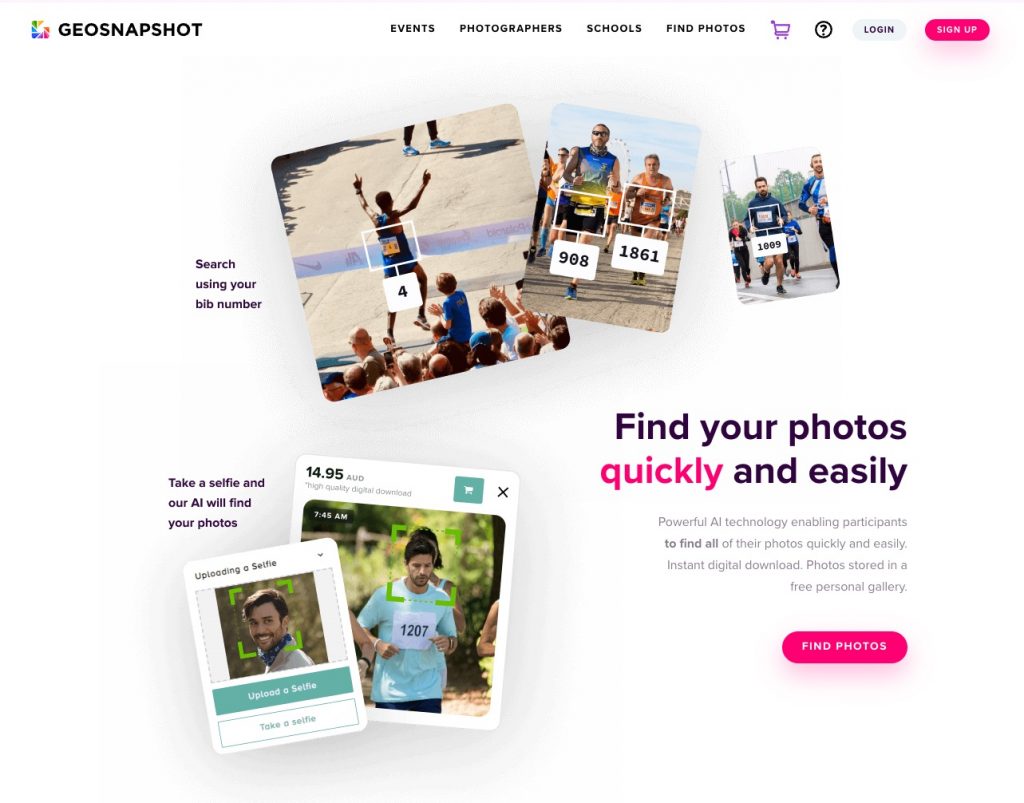
GeoSnapShot is built for professional photographers, to help them quickly and painlessly distribute their photos.
They focus on sports events like marathons, and have developed a unique AI technology to search for photos with face recognition and bib numbers.
Just upload your photos after the event, and GeoSnapShot will take care of the rest.
This is a major time saver for both the photographer and participants. Because it’s easier for participants to find their photos, it’s also more likely that they will purchase them.
GeoSnapShot’s service is free, and they charge a 30% commission only when you sell your photos through their platform.
WaldoPro
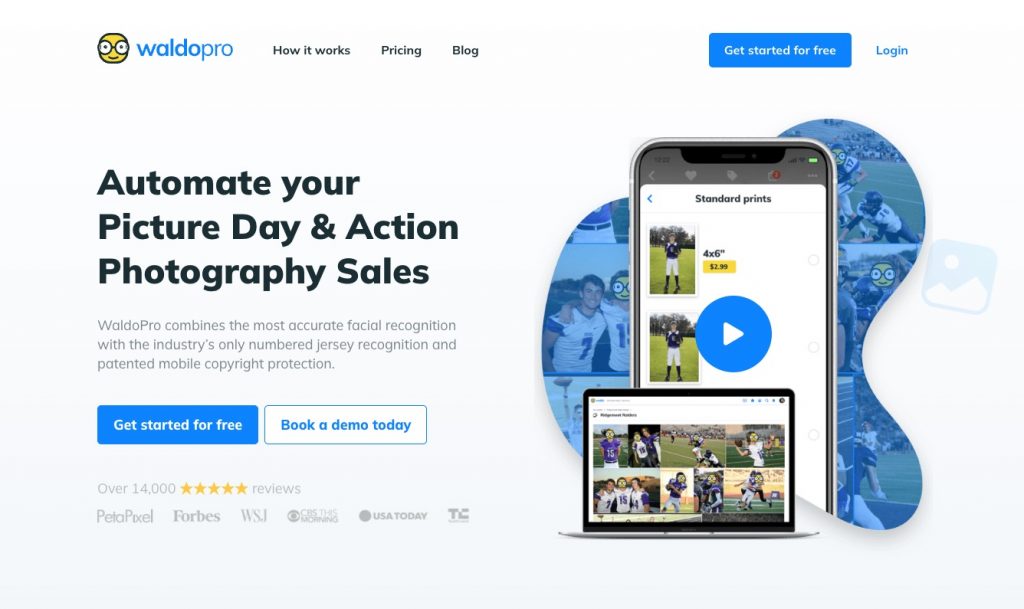
Like GeoSnapShot, WaldoPro helps professional photographers distribute photos with face recognition and numbered jersey recognition.
They focus on sports and school events, helping you make money by selling digital downloads and prints.
Waldo also offers an SMS and email remarketing system—to automatically contact visitors who have not made a purchase, to try to convert them into sales.
Waldo doesn’t charge any upfront fees, and only takes 10% commission on sales generated from their platform.
PhotoDay
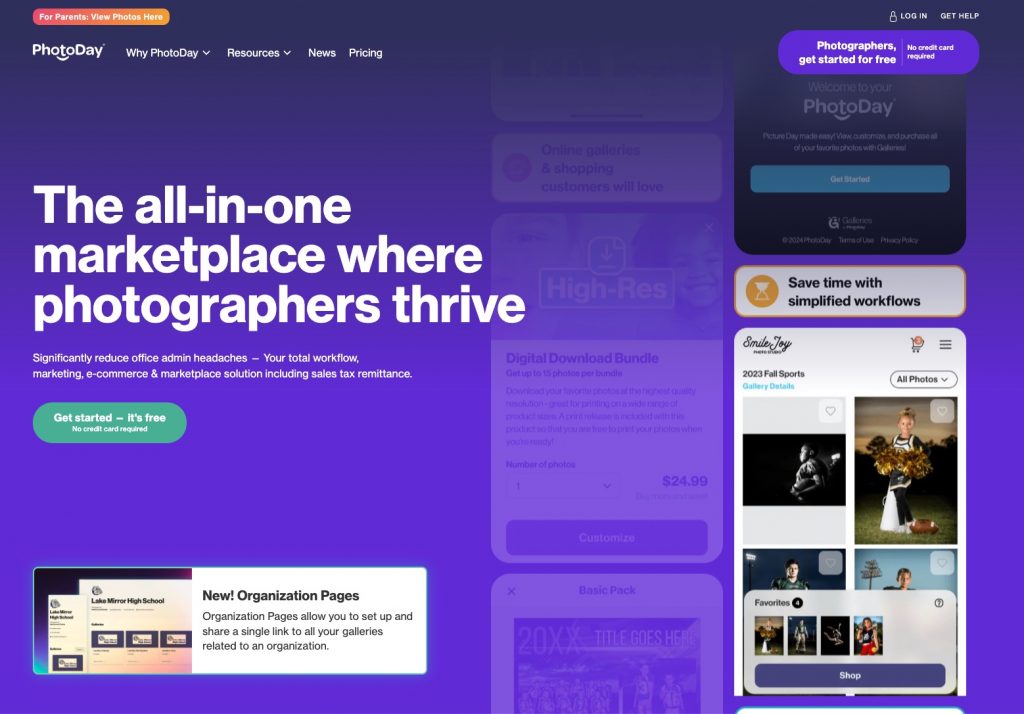
PhotoDay helps to simplify the workflow for photographers, to monetize their events.
Like GeoSnapShot and WaldoPro, they offer face recognition so that attendees can easily find and purchase their photos.
They have partnered with printing labs, so you can offer a variety of prints and products—all without having to do any of the work yourself.
PhotoDay is free to sign up for. They only charge a fee when you sell through their platform, and it includes a 10% transaction fee and 2.9% credit card processing fee + USD0.30 per order transaction.
Proofpix
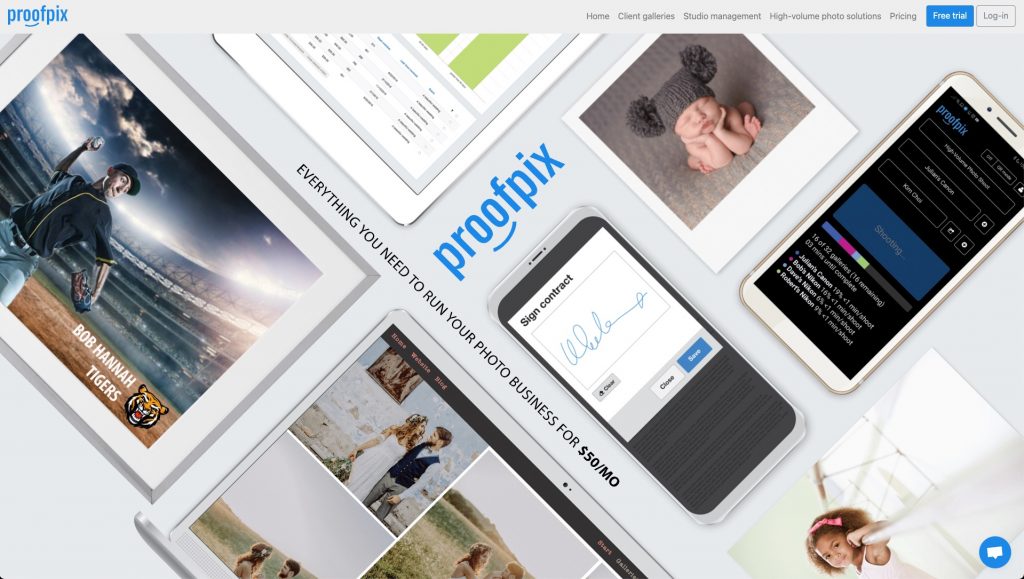
Proofpix offers client galleries, studio management tools and high volume photography tools, all in one platform.
The high volume photography tools are designed to streamline your school, sports or event photography. They do two main things:
- Tag and track participants, and send them their personalized galleries after the event so they can purchase the photos.
- If you’re shooting with a green screen, it can automatically replace the green screen with different backgrounds.
Proofpix offers a 14-day free trial, and paid plans start at USD50 per month.
Build a Website
If you’re looking to turn professional, one of the first things to do is to create a website to showcase your portfolio.
There are many website builders that help you to do that without knowing anything about code.
All of them offer templates if you don’t want to design something from scratch.
But if you want a website that’s unique just to you, they also have drag-and-drop interfaces that let you customize to your heart’s content.
Need inspiration? Refer to our list of 30 notable photography portfolios and learn from the best.
Format
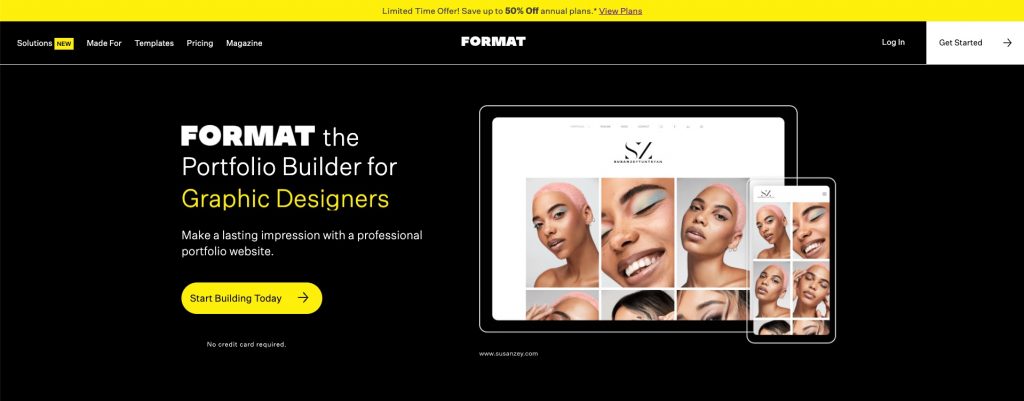
Format is a highly popular photography website builder, offering nearly 100 professionally designed templates.
Their templates are beautifully minimal, letting your photos take center stage.
On top of their website builder, they also offer client galleries with proofing, and an online store to sell your work.
You can even upload photos to your website directly from Lightroom or Capture One.
Format’s primary audience is photographers, so many of its features are specifically built for them—which can be a great advantage compared to other website builders aimed at a general audience.
Format offers a 14-day free trial. After that, paid plans start at USD12 per month.
Squarespace
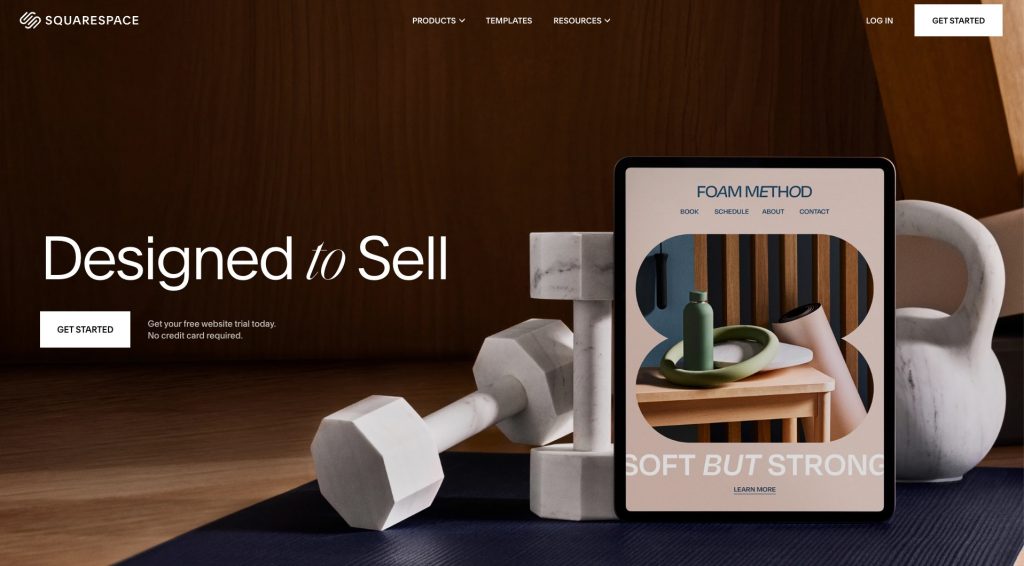
You have probably already heard of Squarespace—it seems like they have sponsored every YouTuber and podcaster.
Unsurprisingly, they are one of the largest website builders, catering to all types of businesses.
Squarespace offers a large selection of templates to choose from, many of which are specifically designed for photographers.
Their drag-and-drop interface can take some getting used to, but it’s relatively easy to build a website from scratch or edit an existing template.
If you want to add a blog or an online store to sell your work, you can do that too.
Squarespace offers a 14-day free trial. After that, paid plans start at USD16 per month.
Wix
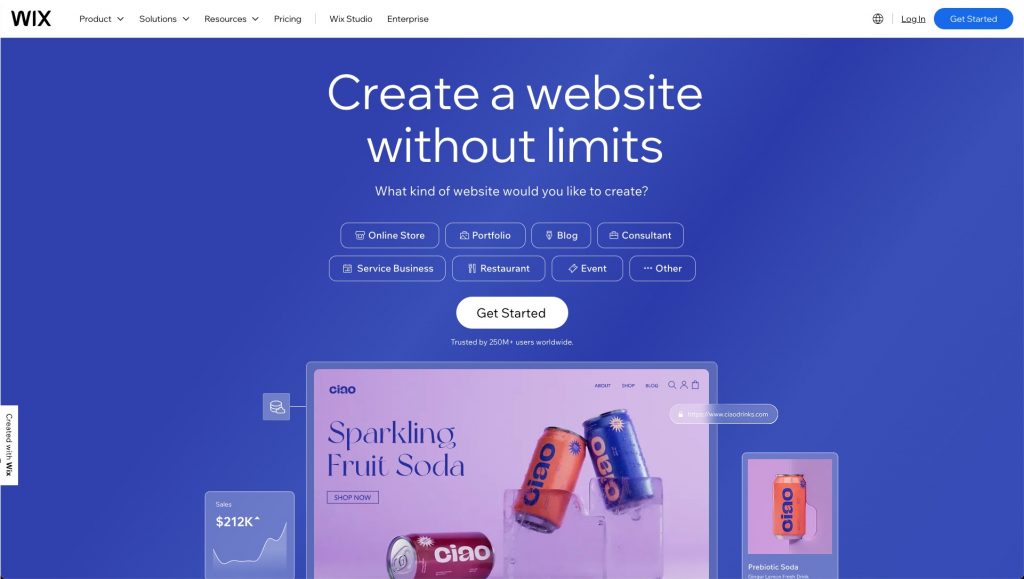
Wix is often seen as the biggest competitor to Squarespace, and it also caters to all kinds of businesses.
Like the previous 2 options, they also offer a good selection of photography templates. In our opinion though, they are not as beautifully designed as Format or Squarespace.
Its drag-and-drop interface is probably the easiest to get into, although all of them come with their own quirks.
Wix offers a 14-day free trial. After that, paid plans start at USD17 per month.
Build an Audience
Social media platforms give you the opportunity to build an audience and connect with your customers.
While many platforms have shifted focus to other types of content, such as videos, there are still platforms that place an emphasis on photos.
Where you decide to build an audience depends on what you hope to get out of it.
Some platforms are designed for a general audience, and are great if you’re looking for potential customers.
Others are targeted specifically for creatives and photographers, and are great for finding inspiration.
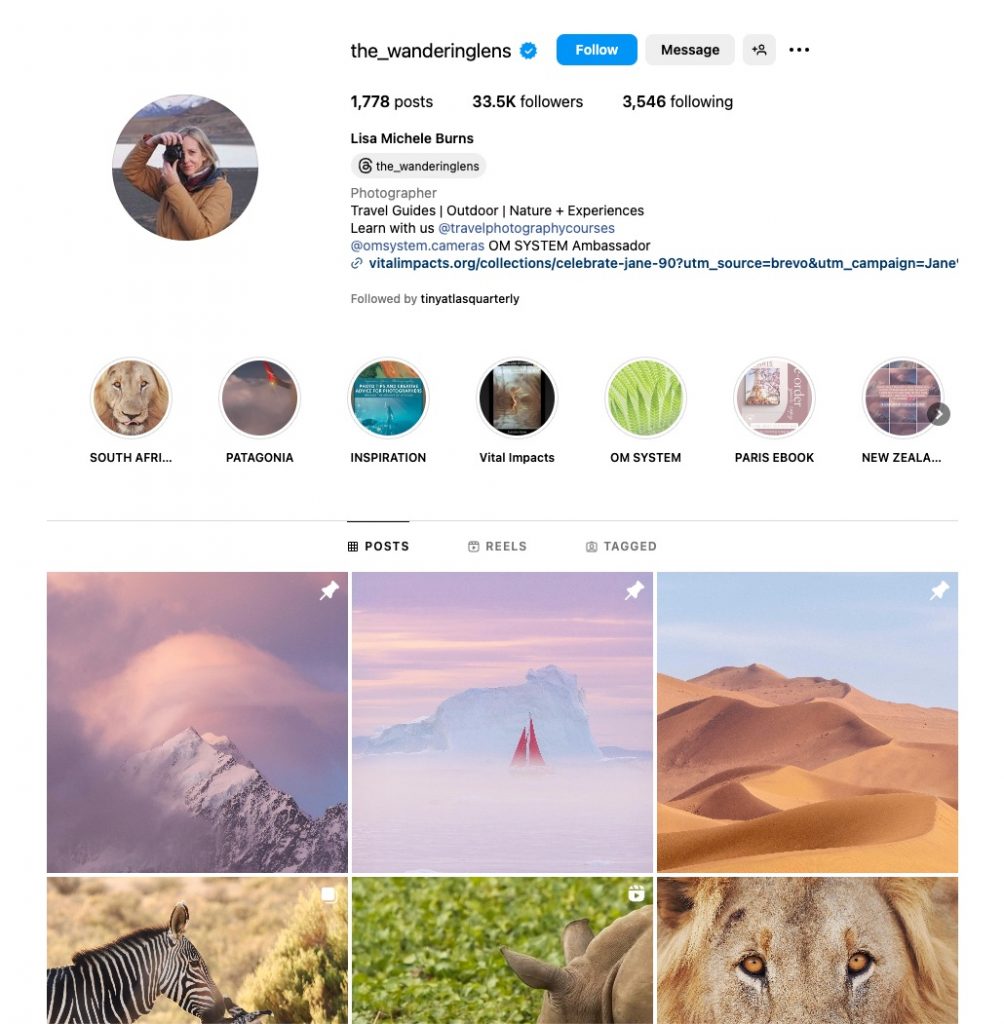
Over the recent years, Instagram has shifted its focus towards videos, in its effort to compete with TikTok.
This can be seen from the type of content it rewards—Stories and Reels get the highest engagement.
Hence, photographers have also started to adapt by creating videos—for example, by showing the behind-the-scenes of a wedding shoot.
Why is Instagram on this list then?
Because where the audience goes, you have to follow.
If you’re looking to connect with potential clients and partners, Instagram is still where they are all hanging out.
And it’s still a great place to showcase your work and demonstrate a unique visual style.
It’s just that the rules have changed, so you now have to mix it up with different forms of content—like short-form videos showing your creative process.
Flickr
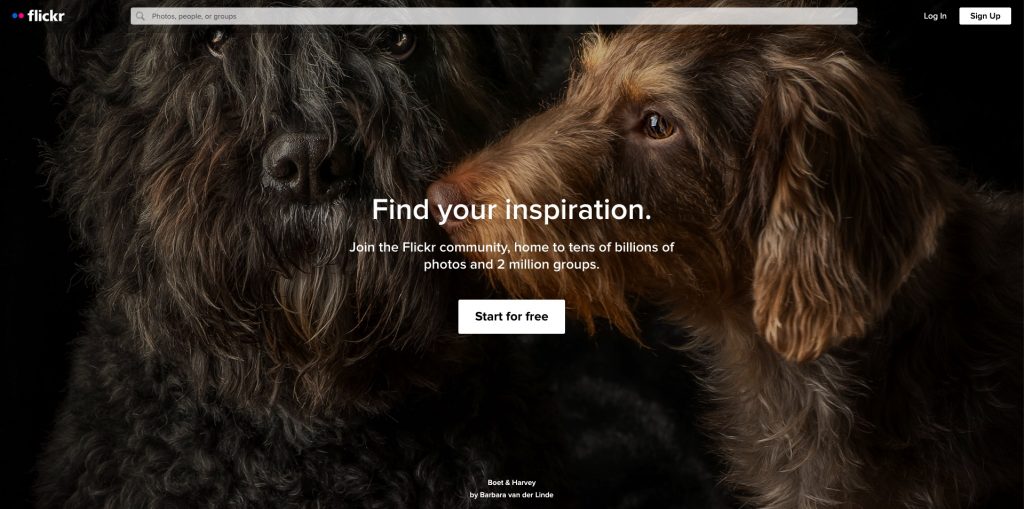
Before Instagram, Flickr was the original social network for photographers.
Even today, it still has an active community—making it a wonderful place to connect with other photographers, find inspiration and get words of encouragement.
Because the focus is on photography, you won’t get distracted by videos or casual photos of someone’s lunch. Hence, the quality to noise ratio is high.
With the free plan, you can upload up to 1000 photos—which is more than enough if you’re just looking to share your photos with other users. Paid plans start at USD9.49 per month.
500px
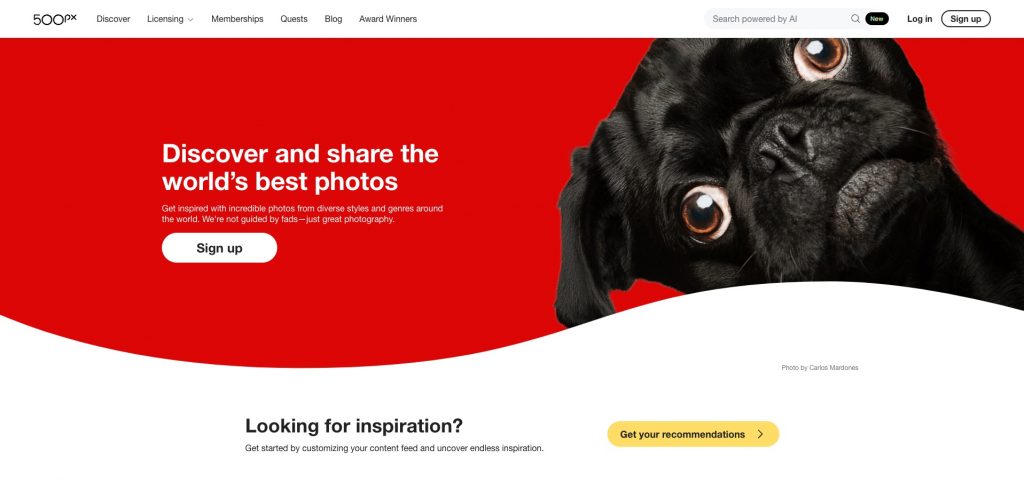
500px is another social platform targeted at photographers, and it has been around since 2009.
In addition to sharing your photos with other photographers, 500px offers features to help photographers build their careers.
You can indicate in your profile that you’re available for hire, enter photo challenges which offer prizes, and license and sell your photos—500px claims to offer one of the highest royalty rates in the industry.
500px offers a free plan with a restriction of 21 uploads per week. Paid plans start at USD6.49 per month.
Behance
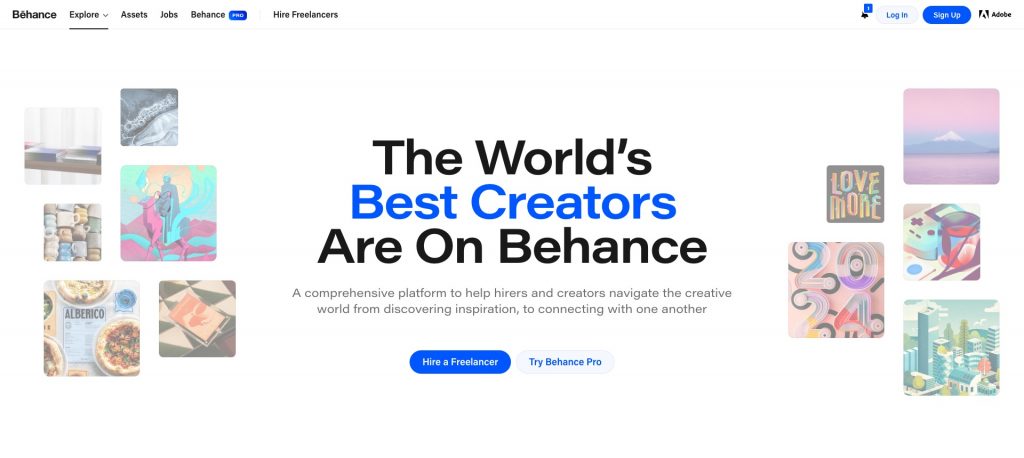
Behance is a social platform for creatives, from graphic designers to photographers.
Hence, it’s an amazing place to get inspiration beyond photography. Sometimes, the best way to get unstuck is to look at other genres for fresh ideas.
In Behance, you can share your work as projects consisting of a sequence of images, which gives you more control and flexibility in telling the full story.
You can also indicate that you’re available for hire, and potential clients can message you directly.
Behance offers a free plan which lets you publish your projects and offer your services, with a 15-30% platform fee for any transactions on the platform.
You can upgrade to a paid plan at USD9.99 per month (with an annual commitment), for features like advanced analytics and a custom portfolio website.
Glass
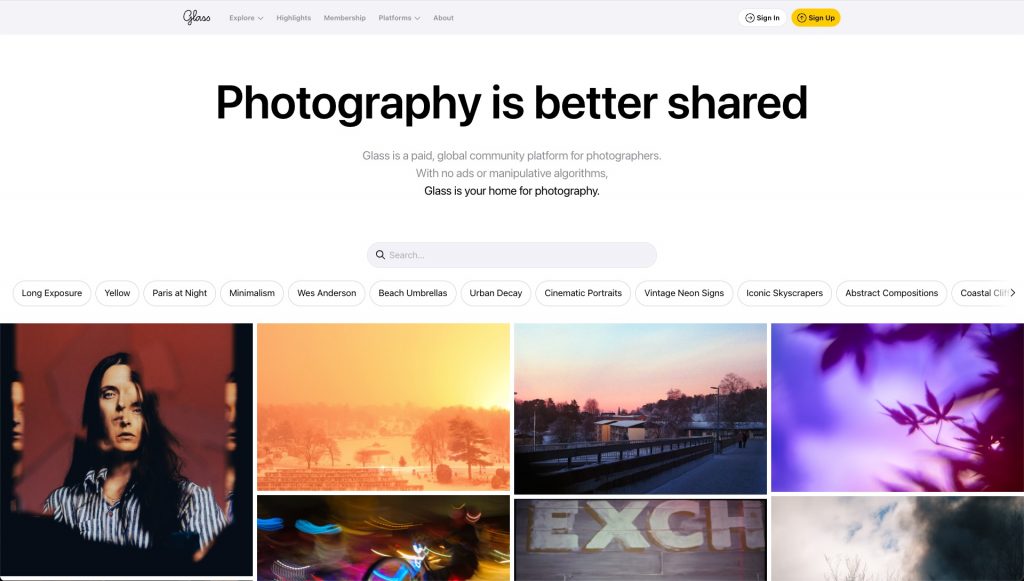
Glass is a paid, global community platform for photographers—it was launched as an alternative to Instagram.
To further differentiate themselves, Glass doesn’t show any ads, use engagement algorithms or show public counts. The idea is to foster a supportive community, rather than a competitive environment that many social platforms evolve into.
Because it’s paid only, it weeds out the casual users and attracts only users who are serious about photography, as well as the vision of the platform.
Glass offers a free plan that only allows viewing. Paid plans start at USD39.99 per year, and allows you to share unlimited photos.
Vero
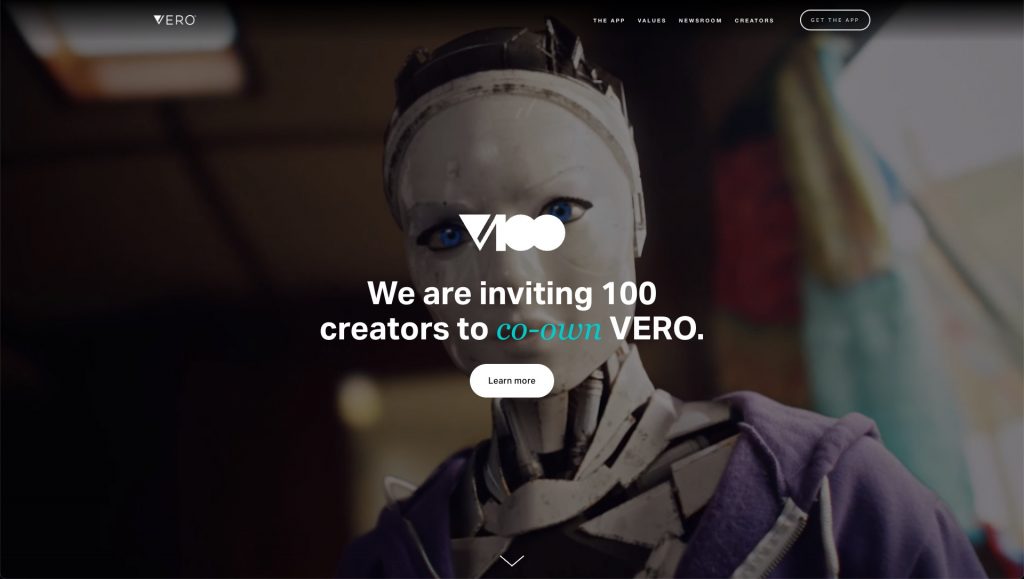
Vero feels like Instagram in its earlier days—a smaller and more active community with higher engagement.
Since it’s tailored for photographers, it allows you to upload full-resolution photos.
It also doesn’t use an algorithm in your feed, giving you more control over how you curate it.
For many photographers, this is a major selling point compared to Instagram—many are frustrated with how Instagram’s algorithm has limited their visibility, even to their own followers.
Finally, Vero doesn’t show any ads, giving you a clutter-free browsing experience.
Store Photos
In our last category, we look at photo sharing apps that are built for storing your photos.
When it comes to cloud storage, speed and reliability are key—so that you can upload your photos quickly, and have peace of mind in knowing that your photos are safe.
It’s also important to be able to share your photos and control access to them, so that you can use these apps to share photos with your family and friends, or deliver photos to your clients.
Google Photos
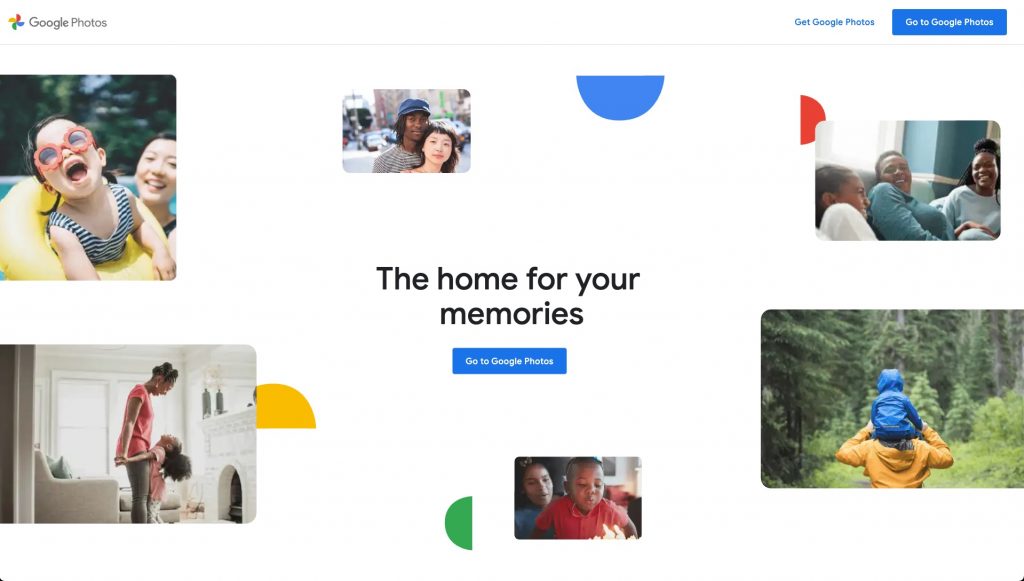
Few services are as universal and functional as Google Photos—it’s used by both casual users and photographers.
You can organize your photos into albums, with full control over who can view or download them.
Google Photos comes with AI face recognition built in, and automatically identifies the people in your photos.
It automatically creates highlights for each album, in the form of a slideshow.
Google Photos can store and display RAW files. For JPEG files, you can choose whether you want to store the full resolution or a slightly reduced quality version to save space.
All of these additional smart features make Google Photos one of the best photo storage solutions.
Google Photos offers a free plan with 15GB of storage. Paid plans start at USD1.99 per month for 100GB of storage, which is shared with Google Drive and Gmail.
Dropbox
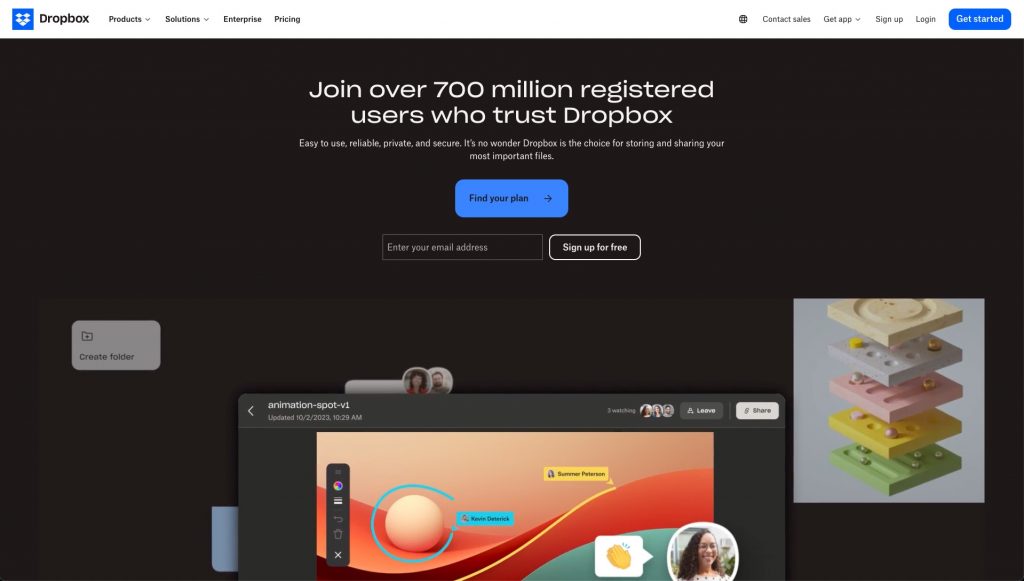
Dropbox is another near-universal cloud storage solution, and it’s great for quick and simple file sharing.
It doesn’t have many of the advanced features of Google Photos, but it’s useful if you simply want to upload your photos and share them with someone else.
It offers some simple photo editing features, so that you can make adjustments to the crop, brightness, saturation and temperature—among others.
That said, the viewing experience isn’t as polished as other services—so it’s useful mainly for transferring files, rather than viewing the photos online.

